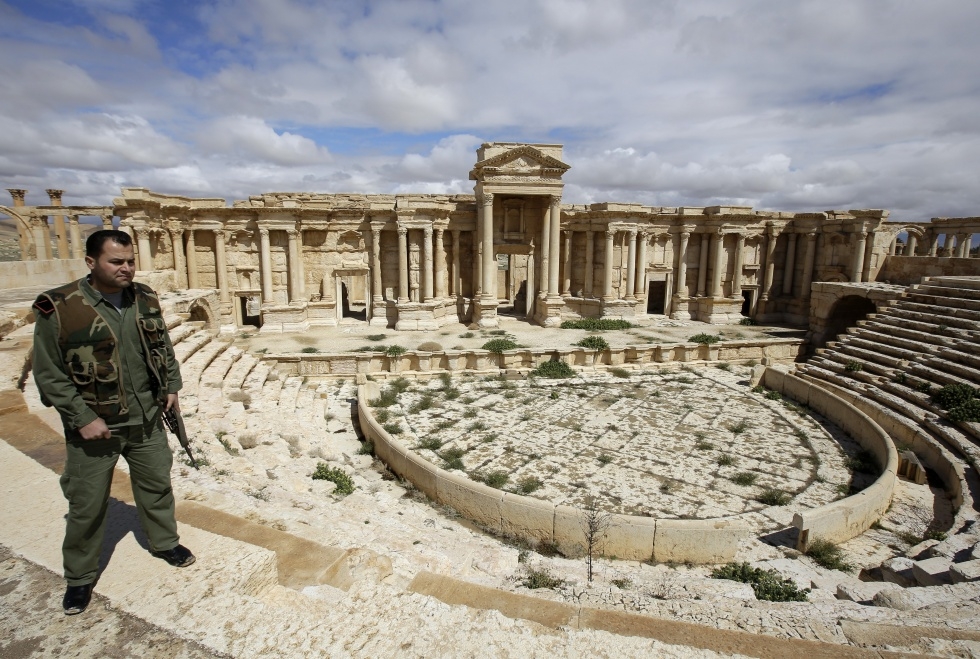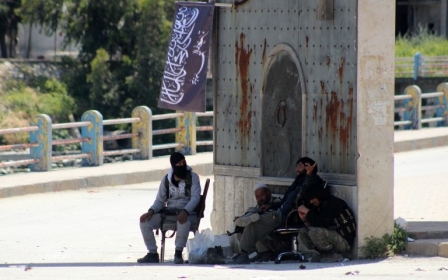Syrian official: World must move quickly to save Palmyra from IS advance

The global community must move quickly to save the ancient Syrian city of Palmyra, which is under assault by the Islamic State group, Syria's director of antiquities told AFP Thursday.
The world "must mobilise before, not after, the destruction of the artefacts" at the site, Mamoun Abdulkarim said by phone.
"If IS enters Palmyra, it will be destroyed and it will be an international catastrophe. You can hide the objects, but how can you save ancient architecture?" he added.
After clashes between IS militant and government troops on Wednesday, IS reportedly launched a two-pronged offensive on Thursday to take the UNESCO world heritage site.
Government troops were said to be shelling the site to thwart the group's advance.
The militants are now said to be just kilometres away from the town, one of the last government strongholds in the area.
Tareq, a resident of Palmyra who spoke to MEE by phone, said the battles in the town were intensifying.
"We are afraid. It's a real war. We didn’t sleep at all last night. We can't go out of the house and we don't know what's going to happen."
"There are snipers outside. The war is on."
Umar Hamza, a citizen journalist inside Palmyra, also told US-based news site, Syria Direct that: “IS took control of the town of al-Amiriya [located approximately 2km north of Palmyra] in order to reach the weapons depots that stretch from the west of al-Amiriya to...[areas] west of Palmyra.”
Late on Wednesday night IS also seized Burj al-Ishara, a strategic high point near the historic 13th century Palmyra Castle, which is situated on a hill overlooking the town’s Roman-era ruins and is some three kilometres from the town centre.
Government forces camped out at checkpoints on the outskirts of the city have responded with heavy shelling, with bombs falling on the ancient town on Wednesday night, local news sites reported. On Thursday morning, airstrikes against IS positions in Burj al-Ishara were also reported, the pro-opposition Sham News Network said.
Within the town of Palmyra a civilian taxi driver was killed, a correspondent for the Turkey-based SMART news agency said.
"We are afraid of both sides taking revenge. If IS take control then they will take revenge on the people for siding with the regime,” Saleh, a local resident, told MEE by phone. "They will behead people in the streets."
“If the regime takes control they will take revenge on the people for siding with IS."
Saleh said residents of the city, whose numbers have been swelled by thousands of people fleeing violence elsewhere in Syria to the relatively stable province of Homs, have been unable to flee. Up to 1,800 families who fled the IS advance in the neighbouring town of al-Suknah are taking refuge in Palmyra.
"The roads are blocked and we still can't get out. It's a risky trip to Homs: it's over 120 kilometres on a dangerous road."
"I am so anxious. I don't care who controls it, we just don't want a long battle. There are people who care about the ruins. But [how can] you care about the ruins? There are civilians here."
Palmyra is located in a largely tribal area of Syria, and gained importance in ancient times as an oasis in the country's extensive southern desert.
Today, the town is mainly inhabited by Syrian bedouins, who constitute up to 15 percent of the Syrian population and have long been marginalised from mainstream politics.
Tareq, another resident of the town, said that his family didn't fear IS nearly as much as Assad or the US-led coalition strikes against IS.
"There is heavy fighting here until now. We think they are trying to take control of the road to Homs," he said.
"We are not afraid of IS but we are afraid that if IS take control, then Assad will bomb us, and the Americans too."
Lightning advance towards ancient city
Local news site Orient Net reported that IS fighters were advancing swiftly towards Palmyra, taking control of two nearby towns within the space of ten hours.
According to the report, IS have taken advantage of this to launch their lightning advance on Palmyra.
Palmyra, in the eastern part of the central Homs province, is one of the oldest cities in the world, and was an ancient caravan stop for people travelling through the Syrian desert.
The town and its castle were made a UNESCO World Heritage site in 1980.
The modern city is a permament home for some 50,000 people, and has been under government control throughout Syria’s more than four-year civil war, apart from a short period between February to September 2013, when it fell under rebel control. On Thursday, smoke could allegedly be seen billowing above the town.
Palmyra used to be a hub for Syria’s tourist industry, but was already badly damaged by fighting before the IS advance.
The town has been subjected to shelling by forces loyal to Syrian President Bashar al-Assad before, with residents of the town telling the Saudi-owned al-Arabiya in 2013 that bombs and shells were coming “from all directions”.
The IS advance towards Palmyra has raised fears that the militants will seek to destroy the ancient ruins, which include a pre-Islamic temple and a Roman temple.
IS militants have previously published photographs of themselves smashing priceless artefacts in the Iraqi city of Mosul, and are said to have “bulldozed” the ancient city of Nimrud in Iraq.
However, the group also sells looted artefacts on the black market, raking in an estimated $100mn a year from the illicit trade.
UNESCO, the UN body responsible for world heritage sites, considers the Palmyra ruins to be of “outstanding universal value”.
A UNESCO delegation visited Cairo on Wednesday to meet with officials from al-Azhar, Egypt’s most prestigious Sunni religious authority.
After meeting with al-Azhar’s Grand Imam, Ahmed al-Tayeb, UNESCO’s director general Irina Bokova praised the institution, saying it was “a very powerful tool to disseminate the true message of human dignity”.
Tayeb stressed during a speech that the destruction of antiquities is “against Islam”.
“Al Azhar was established 1000 years ago, and no scholars of Islam ever legitimised the destruction of cultural heritage”, said the Grand Imam.
Middle East Eye propose une couverture et une analyse indépendantes et incomparables du Moyen-Orient, de l’Afrique du Nord et d’autres régions du monde. Pour en savoir plus sur la reprise de ce contenu et les frais qui s’appliquent, veuillez remplir ce formulaire [en anglais]. Pour en savoir plus sur MEE, cliquez ici [en anglais].




